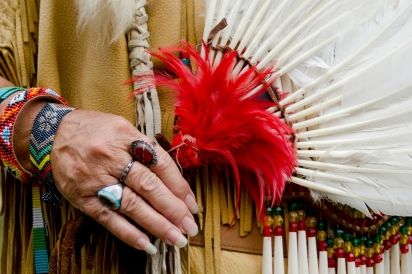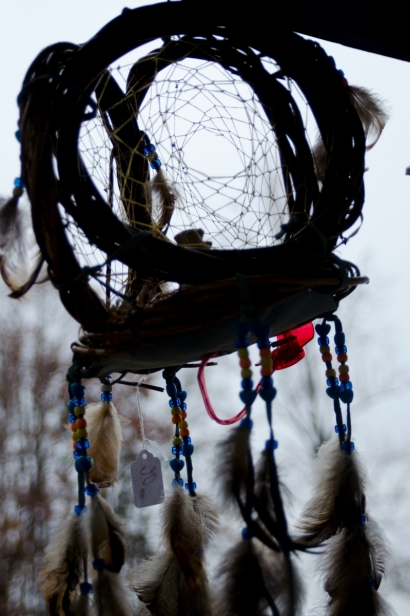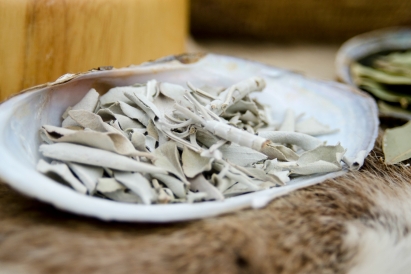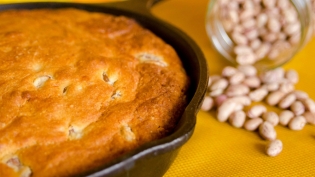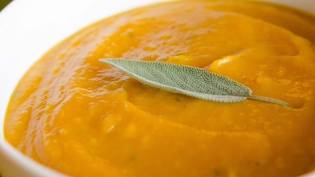Cherokee Foodways Past and Present
Fall is on its way. Summer’s grasp on the world is fading. Soon we’ll be treated to brilliant blue autumn skies and crisp, cool nights. The garden will be rimed with frost one morning in the near future, making way for winter roots and greens. No doubt that first frost will inspire some frantic twilight harvests of tender crops like tomatoes and basil, but that urgency is a pale shadow of times long gone. Unlike our European ancestors and the Cherokee who tended this land, we are complacent in the knowledge that if we miss that last window of opportunity there is always a grocery store just down the street. It’s filled to bursting with the modern panoply of fruits, vegetables and herbs, regardless of the season.
For the vast majority of human history, the advent of fall was cause for both celebration and consternation. Communities rejoiced in the abundance of food coming in from the fields, often holding harvest festivals and feasts even while they worried and wondered if the season’s bounty would see them through the long, lean winter months ahead. Before electricity brought modern conveniences like refrigeration and frozen storage, and even before the home canning movement emerged in the 1800s, winter survival hinged on summer preparation.
Being a farmer myself, I like to think I’m well connected to the changing seasons and familiar with the challenges of feeding myself. But in truth, I know I have it easy compared to my forbears. It’s hard for us contemporary Americans to imagine our lives revolving around food so thoroughly. To be sure, we spend what seems to be a large portion of our time wondering what’s for lunch or dinner, or what we need to pick up at the store on the way home from work. Yet we have no concept of what it truly means to live a life in which the production, processing and cooking of food occupies a significant portion of each and every day.
- 1 -
The Cherokee people certainly understood that life. One of the largest native tribes in North America, their territory once covered a large portion of the southern Appalachian Mountains and included parts of Alabama, Georgia, South Carolina, North Carolina, Tennessee, Kentucky and Virginia. This area is composed of at least 14 different types of microclimates, over 100 species of native trees, more than 1,400 species of flowering plants, at least 2,000 species of fungus and hundreds of species of both vertebrate and invertebrate animals.
As with all indigenous peoples, the Cherokee began as hunter-gatherers, relying on wild plants and game for their sustenance. Wild plants constituted the bulk of their diet during the summer months when vegetation was abundant, while hunted meat saw the people through the winters. Fruits and berries were particularly important foods that could be preserved by drying to bridge the hunger gap; huckleberries, serviceberries, wild strawberries, crabapples, blackberries, raspberries and wild grapes were common choices. Nuts—including American chestnuts, hickory and pecan nuts, butternuts and black walnuts—also figured heavily in the Cherokee diet. After harvesting in the fall, they could be kept in the shell and stored in tightly woven river cane baskets or clay pots for months until needed—although it was important to monitor them regularly for signs of spoilage and insect damage.
By the time Europeans arrived in North American, the Cherokee were an agrarian culture, cultivating their staple crops in gardens around their settlements. However, foraged foods remained an important part of their diet because they were relatively easily obtained, easily stored and provided a diverse array of proteins, fats, vitamins and minerals.
Game meat constituted a significant portion of the traditional Cherokee diet, both before and after their adoption of agriculture. The usual suspects, like deer, turkeys and freshwater fish, made regular appearances on the menu, but the Cherokee also partook of a wide variety of animals that are less commonly consumed today: frogs, squirrels, rabbits, groundhogs, raccoons, opossums, bears and even insects like yellow jackets and locusts. The fat (or grease) from mammals and from bears in particular, was a prized cooking ingredient. Most of the wild greens and mushrooms, including sochan, poke, ramps, creasey greens and wisi, foraged by the Cherokee were prepared in a two-step process that called for first parboiling and then frying the vegetables in grease.
Most of us have heard of the Three Sisters— squash, corn and beans, which were the three staple crops most frequently cultivated by the Cherokee and other Native American tribes throughout North America. The sisters were grown close together in a type of companion planting. The corn stalks provided natural trellises for climbing pole beans, the nitrogen-fixing beans returned fertility to the plot at the end of the season to feed next year’s corn, and the low-growing winter squash vines shaded out weeds and helped keep the soil cool and moist.
Each of the sisters was an important storage crop, but corn, or selu in the Cherokee language, figured most heavily in their diet and culture. Some Native American tribes grew small quantities of sweet corn for fresh eating, but for the bulk of their diet they relied on flint and flour corn. Flint corn varieties have an extremely thick and tough endosperm, or kernel interior, and are most suitable for grinding into cornmeal. Flour corn varieties have only a very thin hard layer enclosing a soft endosperm that can be ground into fine flour. Flour corn varieties require longer periods of high temperatures to properly mature, and were grown more frequently by Native Americans of the Southeast and Southwest.
While corn is easy to store and easy to remove from the cob, it does have a major disadvantage as a staple crop: In its raw state it is deficient in free niacin, part of the B vitamin complex and a nutrient essential for human health. Mesoamerican tribes long ago developed a process called nixtamalization, wherein dried corn is soaked and cooked in an alkaline solution called limewater. The nixtamalized corn is more nutritious, tastes better, is easier to grind into flour and holds together to form dough for cooking. This process spread through the Americas with the spread of corn itself, and traditional corn was a healthful staple crop for the Cherokee. But when Europeans adopted corn into their agriculture and diets, they neglected to adopt the nixtamalization process as well. European people eating a diet composed primarily of unprocessed corn became niacin deficient, a condition that often resulted in the debilitating and regularly fatal disease called pellagra. In the early 1900s, pellagra reached epidemic proportions in the South—the Spartanburg Pellagra Hospital was the first facility in the nation dedicated to discovering the cause of pellagra—and it is still common in modern populations that rely on unprocessed corn as a staple food.
Cherokee legends tell of the origin of corn—it came from the blood of Selu, the Old Woman, who was killed by her foolish sons—and a number of ceremonies and festivals accompanied the variousstages of the crop. The Green Corn Ceremony featured cleansing rituals and occurred around July, when the ears of corn were still green but big enough to roast and eat. Later in the season, around September, the Ripe Corn Ceremony was an occasion for thanksgiving that occurred when the whole crop was ready for harvest.
The Cherokee also celebrated the thirteen full moons of the year, including that of Duninudi, the harvest moon. The harvest moon is the full moon that occurs closest to the autumnal equinox. For the Cherokee, it was a time to give thanks for bountiful harvests and abundant game. The idea of a time for rest and gratitude transcends the boundaries of culture and time, and is a common thread woven through the fabric of agricultural communities the world over. This tradition still lives on in modern Cherokee culture.
- 2 -
Nestled within the heart of the Blue Ridge Mountains lies the town of Cherokee, North Carolina. It is part of the Qualla Boundary, a small portion of the ancestral Cherokee territory and modern-day home of the federally recognized Eastern Band of Cherokee Indians, who are the descendants of those that escaped forced removal on the Trail of Tears in the 1830s.
The road to Cherokee winds lazily through sleepy coves, surrounded by lush forest that occasionally parts to reveal breathtaking views of the mountainsides. Cherokee is both a tourist destination, featuring the Museum of the Cherokee Indian and the Oconaluftee Indian Village, and a hub of culture and identity for the local Cherokee tribal members. I decided to visit the town in early October for the Cherokee Indian Fair, a five-day celebration of Cherokee history, food and culture, hoping for a taste of some of the traditional foods I’d read so much about.
On the surface, the century-old Cherokee Indian Fair could have been any other rural county fair taking place on a crisp fall day. Amusement rides clustered just inside the fairgrounds, and the ubiquitous cotton candy and candy apple stands were hard to miss. But in the parking lot I’d already spotted something very different: On the far right side of the fairgrounds, a sea of white pop-up tents abutted a long, narrow building. It was only 10am but the tents were already a hotbed of culinary activity, with long plumes of hot steam drifting up from huge stainless steel pots perched on portable burners.
I quickly discovered this was the main concession area, but the windows wouldn’t open up for service for another hour. With time to spare, I made my way to the exhibition building next door. The displays there were a seamless blend of the traditional and the modern. Hand-woven baskets stained with natural dyes sat across from acrylic paintings on canvas. The largest displays were protected by plastic mesh and bore the names of local Cherokee communities. Each display contained carefully arranged assemblages of crafts, home goods, clothes, fresh and dried foods, and photos and other mementos that represented the community members. These displays were clearly a labor of love, a celebration of each community’s living history.
A prodigious number of foods were piled high within the displays—some, like the baskets of corn and beans, were thoroughly traditional while more modern preparations, like canned berries and tomatoes in quart Mason jars, formed orderly rows behind them. Strings of “leather britches”—dried green beans—hung alongside Southwestern-style ristras of dried hot peppers. The graceful curves of winter squashes and prickly dried heads of sunflowers peeked out here and there. Some of the foods on display were European introductions that the Cherokee incorporated into their diet: dried cabbage leaves, apple slices and Irish potatoes by way of Peru. But the vast majority were New World crops, a testament to the endurance of tradition.
Back at the concessions area, the stands were open. Reading the menus was like watching the past and present collide and combine into something entirely new. Most of the stands offered traditional foods, like bean bread, with the option to add toppings like chili, shredded cheese, and ground beef. I was probably one of the few people there with an order of plain bean bread and I soon discovered why: it’s something of an acquired taste.
Bean bread is perhaps one of the most well known Cherokee foods. In 1951, the Museum of the Cherokee Indian published a short cookbook called Cherokee Cooklore. The first half of the cookbook consists of an account of the traditional Cherokee method of making bean bread as related by Aggie Lossiah, the granddaughter of Chief John Ross. It includes photos of the entire process, from nixtamalizing the corn to pounding the flour in a wooden beater to shaping the bean-laden dough into “broadswords” and wrapping it in corn leaves for boiling. The lack of salt in traditional bean bread was challenging for my modern palate, but I soon learned that if salt were added, the broadswords wouldn’t hold together when boiled.
I found a more familiar sort of bread in the fry bread at the fair. Most of the vendors offered a choice between savory and sweet toppings; I chose cinnamon sugar for mine and it reminded me strongly of the elephant ears served at county fairs all over the country. Fry bread is not a uniquely Cherokee dish. It was actually created by the Navajo people, who were themselves displaced from their ancestral lands in 1864 and forced to relocate to land in New Mexico where their traditional staple crops could not be grown. In order to keep the people from starving, the federal government provided rations—among them white flour, white sugar and lard. Unfamiliar with these foods, the Navajo women applied traditional cooking techniques to their new ingredients and created fry bread, which is essentially a flat slab of fried dough.
Although fry bread is delicious, it’s also surrounded by controversy. Some see it as a symbol of the pain and loss of forced removal, and there is no disputing that it is a distinctly unhealthy food compared to the traditional diets of Native Americans. Nevertheless, it has also come to stand for Native American unity and is a fixture at the powwows and festivals of many tribes in the United States.
I lingered at the fair for a while, taking in more exhibits, looking at vendor booths, and watching some of the special events like stickball games and corn shucking contests. On the drive back home, I mulled over the intriguing mix of old and new I’d seen and tasted. While learning about a culture so rich in history and traditional foodways was exciting, I was struck by sadness for the great losses the Cherokee people have experienced: the loss of land, the loss of agency, the loss of heritage. And I felt sadness for the loss we all, regardless of origin, are experiencing—the loss of connection with the natural world, the loss of a sense of place, and the loss of food security.
There is always an element of grief in fall. We grieve for the loss of the long days and warm sun. We grieve for the fading gardens and fleeting pursuits of summer. But the harvest moon is also a time of celebration, of gratitude for the great abundance of the land, of foods that nourish both body and spirit.



